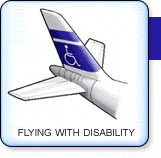 |
||
| Home Our Message Preparation Advanced Planning The Day of Flying About the Aircraft Medical Certificates Oxygen Protecting your wheelchair Travel Insurance Working with the Airline Part 1 Part 2 At the Airport Accessibility at the Airport At the Airport Security Screenings Onboard the plane Boarding the Aircraft Medical Assistance Flying with a wheelchair Flying with guide dogs Know your rights Discrimination Knowing Your Rights Making a Complaint Post 9/11 Other Resources Disability Links General Travel Links Overseas Property Check out our new site: Overseas Property Disclaimer Contact us |
||
Flying With Disability
| Accessibility at the airport | |
|
Accessibility at the airport is like that of many public buildings around the world. Only in the last two decades has wheelchair accessibility became a genuine consideration for the architects of modern airports. Since different countries have differing regulations regarding the accessibility of public buildings, so their accessibility to the disabled traveller varies. In the US, following the Americans with Disabilities Act of 1990 (ADA) and the implementation of these regulations, so all airports must be made accessible to disabled travellers. Likewise, all refurbishments must comply with similar regulations. Following these changes airports should provide the following services for disabled travellers:
Within the airport itself, disabled travellers should have ease of access between check-in counters, security check points and boarding terminals. This is usually accommodated through lift and ramp access. |